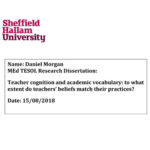Planning and Teaching Creatively Within a Required Curriculum for Adult Learners
Anne Burns and Helen de Silva Joyce (Eds.). Alexandria, VA: Teachers of English to Speakers of Other Languages, 2007, Pp. iv + 288.
Reviewed by Ko-Yin Sung
Utah State University, Utah, USA
In the book Planning and teaching creatively within a required curriculum for adult learners, Burns and de Silva Joyce illustrate examples of creative curriculum changes to current and future teachers and teacher trainers who may encounter teaching conditions in which they are asked to adapt curriculum which does not match their teaching styles or expectations. To do this, the authors present teachers’ and teacher trainers’ research articles on making changes to curriculum that they (the teachers) had no involvement in designing but were required to teach.
The book consists of 13 chapters. Chapter 1 introduces the backgrounds of the 12 research studies in the book, including the extent to which changes were made and what prompted the changes. The scale of change made in each of the 12 study sites ranges from institutional changes, which refer to long-term changes implemented across the institution; to component changes, which affect one aspect of curriculum across the institution; and to classroom changes, which are changes limited to individual classrooms.
Chapters 2 and 3 are descriptions of two research projects involving institutional changes, both of which refer to long-term implemented institution wide changes. Chapter 2 outlines the modifications of the English course curricula in two Central Australian educational institutions. The old curricula focused on language teaching while the new one combined teaching of language and vocational competencies. The authors describe the use of a gardening project which provided ESL learners with purpose and context for learning. Chapter 3 details the development of a study skills program initially designed to improve students’ learning strategies and how it flourishes and becomes a core element of the first-year basic introductory seminar at Okinawa University. The seminar originally was an introduction to the lecturer’s specialization for the students, but after the change, the teaching of study skills became the focus of the first-semester seminar.
Chapters 4 to 6 focus on examples of component changes, which might be taken up more broadly across the institution. In chapter 4, the author incorporates action research as part of the required tasks for a TESOL postgraduate certificate program in Vietnam, which increases the development level of the postgraduate students’ teaching skills. Chapter 5 offers an example of innovative curriculum development in which a group of elementary students and a group of international college students in Hawaii effectively and engagingly collaborate on producing children’s literature. Chapter 6 describes the innovation of a highly practical learner-centered language learning project implemented for English for specific purposes courses at a Thai University.
The remainder of the book, chapters 7 to 13, focuses on changes limited to individual classrooms. Chapter 7 describes the successful use of a non-traditional textbook to improve students’ literacy skills in an adult ESL class in the United States. Chapter 8 demonstrates how a new literacy project that improved the motivation of ESL students in the United States as they read a murder mystery and wrote about the historical background of the story. Chapter 9 offers ideas about how incorporating arts, music and poetry into a high-stress adult ESL classroom in the United States may enlighten language learners. Chapter 10 demonstrates a project in Japan that used students’ L1 as a starting point to help them develop appropriate language use in the target language. Chapter 11 suggests that teachers should use the teaching of critical inquiry techniques, such as using self-designed interactive activities to engage ESL learners in effective and active debates. Chapter 12 shares an example of using genre approach to writing instead of a standard teaching package to enhance students’ writing level in an intensive ESL program in Cambodia. Chapter 13 provides examples of using freewriting as a way of boosting students’ confidence level.
The diverse learning and teaching contexts discussed in Planning and teaching creatively within a required curriculum for adult learners give a wide range of successful curriculum change examples which can be easily applied to teacher-readers’ teaching situations. These successful examples serve as curriculum change models for teachers who are eager to make changes to their curriculum and hungry for new ideas.








